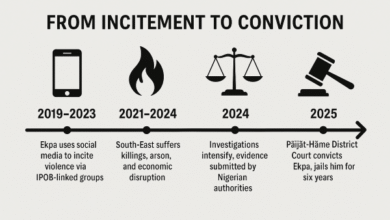Hardship abroad force Nigerian migrants back to Nigeria – NBS

A recent study by the National Bureau of Statistics (NBS) has revealed that hardship is the leading reason why Nigerian migrants abroad return home, accounting for 47.9 percent of the returnees.
This is contained in the “Awareness and Perception of Intending and Returned Migrants on the Dangers of Irregular Migration 2022″ survey report released in Abuja on Thursday.
The NBS said a total of 2,400 households were sampled from six purposive states from each of the six geopolitical zones.
They are: Anambra (South East), Edo (South South), Lagos, (South West) Benue, (North Central) Gombe, (North East) and Kano (North West).
The bureau said the purpose of the study was to collect data and provide evidence on the awareness and perception of intending and returned migrants and raise awareness on the dangers of irregular migration.
“It study also seeks to highlight government efforts towards combating the prevalence of irregular migration in Nigeria.
“This evidence is expected to provide a database for policy formulation in line
with the increasing demand for data-driven human development initiatives” the report said.
The NBS said the 2022 migration survey expanded its focus to cover the two other vulnerable groups namely, Almajiris and House Helps.
“Key findings from the report showed that the average age of the respondents is 27 years, about 60.1 per cent of them are from the urban area and 51.8 percent have attended secondary education”, it showed.
The study further showed that about 24.9 percent of the respondents indicated engaging in business as the reason for traveling abroad, followed by 22.6 percent who said they went there to work.
Those who said they left for `greener pasture’ make up 21.4 percent of the respondents.
However, the report revealed that a majority of the respondents, 48 percent, said hardship forced them to return home. They followed by deceit at 20.1 percent.
“This was followed by “no papers at 16.4 percent “; `no job` at 13.8 percent, and `crime` at 1.7 percent. ”
The study showed that Kano state recorded the highest number of returnees from abroad at 39 percent, followed by Lagos at 20.7 percent.
“This was followed by Edo at 16.7 percent, Anambra at 11 percent, Gombe at 8.7 percent, and Benue at 3.9 percent “, the report said.
The survey showed that 31.8 percent said detention was the climax of their suffering in the course of their stay abroad. They are followed by 30.8 percent who pointed at hunger.
The report said “deportation accounted for 15 percent, slavery/forced labour at 12.1 percent, and sexual abuse at 7.5 percent. ”
It showed that Edo state recorded 52.4 percent of returned migrants who would want to travel back in spite of the risk involved.
“This was followed by Lagos at 14.29 percent, Anmabra at 12.70 percent, and Benue and Kano at 1.59 percent. ”
On returned migrants and the sources of assistance upon return, the study revealed that philanthropists constituted the majority of sources of relief with 24.8 percent of assistance to returnees.
This was followed by Federal Government at 21.5 percent, international organisations at 19 percent, Non-Governmental Organisations at 15.7 percent, and state government at 12.4 percent.
“On the contrary, Civil Society Organisations recorded less than one percent
of support to the returned migrants”, the report said.
The study revealed that 68.2 percent of rural households and 31.8 percent of urban households send their children or wards to Almajiri.
The survey showed that 98.6 percent of the households interviewed sent their children or wards to Almajiranci to acquire Quranic education and religious morals.
“While those that sent their children because it is free of charge and those that see it as a religious obligation had 0.7 percent each”, the NBS report said.
The study also showed that 47.7 percent of the households who give out their members as house help do so because of hardship.
The NBS said the data was collected through National Integrated Survey for Households (NISH) which provides direct interactions with eligible respondents at the households using questionnaires.











